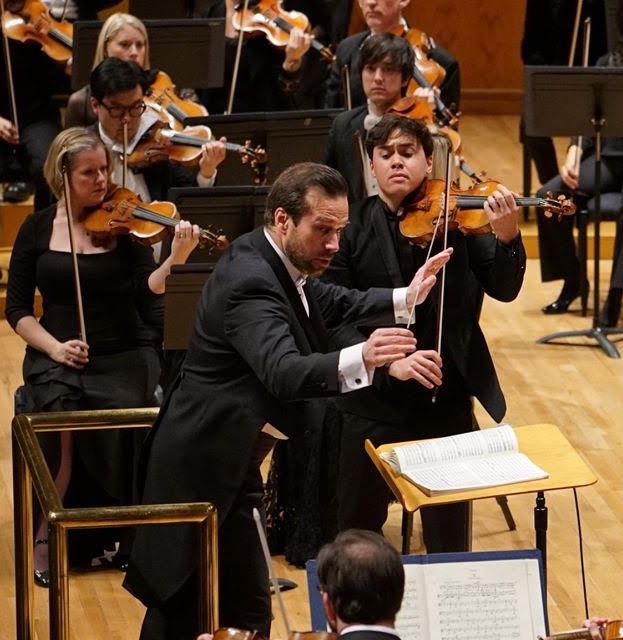Violinist makes outstanding debut in Utah Symphony’s Spanish-flavored program

This weekend’s Utah Symphony program is titled “Sketches of Spain,” but it should really be called “The Benjamin Beilman Show.”
Making his Masterworks debut Friday, the young American violinist gave a knockout performance of Lalo’s Symphonie espagnole, a work not often heard in Abravanel Hall. His reading displayed a level of maturity that surpasses his 30 years. That quality—combined with the depth of expression he brought to his performance, as well as his technical chops and interpretative skills— certainly place him in the forefront of today’s young concert violinists.
Beilman attacked the opening measures of the first movement with bold strokes and dramatic flair, and contrasted that nicely with mellow phrasings in the softer passages. And there were always seamless transitions between these sections that brought a natural flow to the music.
The soloist gave the second movement a light treatment with his nimble playing that captured the good-natured spirit of the music. The same also held true for the finale. Beilman played it with carefree abandon that underscored the playfulness of the music.
In between, the third movement Intermezzo was rhythmically vibrant and driven, while the fourth movement Andante was darkly lyrical, with the soloist giving a decisive reading that brought out the expressiveness that courses throughout this movement.
Beilman also treated the audience to an encore: Kreisler’s Recitativo and Scherzo, Op. 6. Dedicated to Ysaÿe, this solo piece demands the utmost in virtuosity and Beilman acquitted himself wonderfully and once again showed his mastery of his instrument. (Beilman is the younger brother of the Utah Symphony’s acting associate violist Elizabeth Beilman.)
Sharing the stage with the youthful violinist this weekend is the French conductor Fabien Gabel in his Utah Symphony debut. Their collaboration was exceptional for the manner in which they played off each other, and Gabel brought a deft balance between the soloist and the orchestra, which responded to his direction with finely crafted articulation and delivery.
After intermission, the Spanish theme of the concert (via French composers) continued with Ravel’s Rapsodie espagnole and the second movement, “Ibéria,” from Debussy’s Images.
Gabel’s sensitive direction of Ravel’s Rapsodie allowed the orchestra to vividly capture the magic and mystery that the composer creates in this four-movement work. Gabel directed the score fluently from the evocative opening “Prélude à la nuit,” and the vibrant rhythms of the “Malagueña,” to the sultry and intoxicating “Habanera,” and energetic and lively “Feria” finale.
Debussy’s take on Spain is markedly different than Ravel’s. The three sections of “Ibéria” are awash in lush harmonies and rich textures that demand considerable attention to subtle inflections of dynamics, tempo shifts and expressions. Gabel captured that and coaxed effusive and vivid playing from the orchestra that brought definition and cohesion to the work.
A delightful surprise was the inclusion of Louis Aubert’s Habanera between the Ravel and Debussy. Gabel has been championing the music of this unjustly neglected French composer, who lived from 1877-1968.
Aubert’s Habanera is anything but a dance. The expansive work is a small tone poem that undoubtedly depicts Aubert’s overwhelming impressions of the Iberian Peninsula. The work is audacious and dramatic, but also invokes the sultry sensuality of the dance which underlies it.
Gabel’s interpretation was forceful and underscored the scope of the work with his sweeping gestures, conveying his intentions to the orchestra succinctly. They, in turn, played with expansive, vibrant expression that gave the piece depth and definition.
The sole work that had nothing to do with Spanish music was Andrew Norman’s Unstuck, which opened the concert. The placing of the work was rather unfortunate since it felt odd and distinctly out of place within the program’s theme.
Typical for Norman’s orchestral music, Unstuck is busy with nervous, unbridled power and bursting with cacophonous sounds and dense textures. Norman knows how to orchestrate and that, when all is said and done, is the main redeeming element in this piece.
The program will be repeated 7:30 p.m. Saturday in Abravanel Hall. utahsymphony.org; 801-355-2787.

